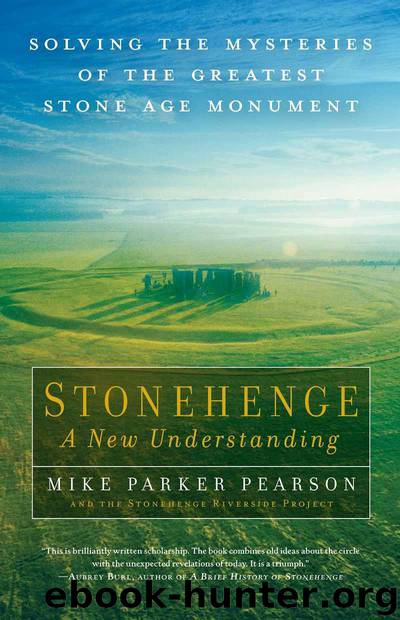Stonehenge—A New Understanding: Solving the Mysteries of the Greatest Stone Age Monument by Pearson Mike Parker

Author:Pearson, Mike Parker [Pearson, Mike Parker]
Language: eng
Format: epub
Publisher: The Experiment
Published: 2013-05-25T04:00:00+00:00
Diggers stand in the holes where standing stones once stood at Bluestonehenge, on the bank of the River Avon at West Amesbury.
The traces left by these upright stones were very different from those left by the narrower and deeper Bronze Age posts that came after them. And the holes themselves were wider and shallower than any of the holes for Neolithic posts at nearby Woodhenge and Durrington Walls. From the shape and size of the holes, we know that the stones they once held could not have been slab-shaped sarsens.
The standing stones had been placed on individually tailored cushions of river clay and pads of packed flint nodules. Each pit base was different, suggesting that the cooperative activity of erecting a stone circle had been carried out by separate teams responsible for each stone. One stone had sat on a carefully constructed nest of nodules, while others merely had a thin cushion of clay between their bases and the chalk. Another sat on a rock-solid pad of nodules and rammed clay.
The bottoms of five of the holes contained imprints of their stones, pressed through the clay cushions into the soft chalk beneath. The profiles (the cross-section shape) of the holes had already indicated that they’d contained neither posts nor sarsens. It now became clear from the imprints in their bases that these holes had once held stones whose pillar-like shapes closely match the Stonehenge bluestones, with their variously curved, indented, and straight edges. We had to think of a name for this unknown site, and called it Bluestonehenge. Extrapolating from the curvature of the nine excavated stoneholes, we calculated that, if the stone arrangement continued to form a circle, it had consisted of twenty-five monoliths.
Radiocarbon dates from antler picks told us when the stones were removed from the stoneholes. Josh’s first find, the pick from the ramp, produced a radiocarbon date of 2469–2286 BC. A second antler pick, found right at the bottom of one of the stoneholes, dated to 2460–2270 BC. The stones had been extracted during the Copper Age, around the same time as the henge ditch was dug, and at the same time as the Stonehenge Avenue ditches were dug.
Working out when this bluestone circle was first erected is a more difficult question. No antler picks were deposited in the stoneholes when the circle was built. This absence of picks at Bluestonehenge mirrors their absence in other bluestoneholes—no picks have ever been found in any of the Aubrey Holes or the Q and R Holes at Stonehenge and there are only two antler fragments from the bluestone circle and oval. Archaeologists all accept that the depositing of antler picks in pits, stoneholes, and ditches was done with deliberation by Neolithic builders, and was not the accidental abandonment of perfectly serviceable building tools; it looks as if it just wasn’t the practice to leave such objects in these holes for bluestones.
We did initially hope that the pick found at the bottom of a stonehole had been put there
Download
This site does not store any files on its server. We only index and link to content provided by other sites. Please contact the content providers to delete copyright contents if any and email us, we'll remove relevant links or contents immediately.
| Africa | Americas |
| Arctic & Antarctica | Asia |
| Australia & Oceania | Europe |
| Middle East | Russia |
| United States | World |
| Ancient Civilizations | Military |
| Historical Study & Educational Resources |
The Daily Stoic by Holiday Ryan & Hanselman Stephen(3235)
The Fate of Rome: Climate, Disease, and the End of an Empire (The Princeton History of the Ancient World) by Kyle Harper(3003)
People of the Earth: An Introduction to World Prehistory by Dr. Brian Fagan & Nadia Durrani(2701)
Ancient Worlds by Michael Scott(2625)
Babylon's Ark by Lawrence Anthony(2620)
The Daily Stoic by Ryan Holiday & Stephen Hanselman(2459)
Foreign Devils on the Silk Road: The Search for the Lost Treasures of Central Asia by Peter Hopkirk(2434)
India's Ancient Past by R.S. Sharma(2416)
MOSES THE EGYPTIAN by Jan Assmann(2373)
The Complete Dead Sea Scrolls in English (7th Edition) (Penguin Classics) by Geza Vermes(2235)
Lost Technologies of Ancient Egypt by Christopher Dunn(2194)
The Earth Chronicles Handbook by Zecharia Sitchin(2180)
24 Hours in Ancient Rome by Philip Matyszak(2049)
Alexander the Great by Philip Freeman(2032)
Aztec by Gary Jennings(1975)
The Nine Waves of Creation by Carl Johan Calleman(1884)
Curse Tablets and Binding Spells from the Ancient World by Gager John G.;(1838)
Before Atlantis by Frank Joseph(1811)
Earthmare: The Lost Book of Wars by Cergat(1790)
